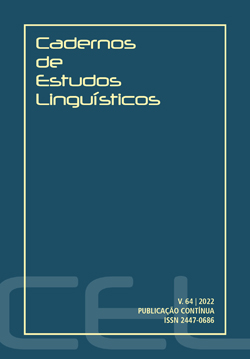Abstract
In studies of Brazilian toponymy, one of the procedures most used by researchers in the analysis of geographical names is the application of a taxonomic model. Dick's (1990b) model, which aims to classify motivating elements objectively and synchronically, includes, for example, the category of chrononotoponyms: toponyms with chronological indicators represented by the adjectives new and old. When highlighting the specific causes, which involve the reasons for the denominator, it is necessary to find out at least some aspects of the history of the named geographical feature; that is, the perspective becomes diachronic. The objective of this study is to demonstrate that in a category like the one analyzed here, the denominative causes, although specific for each designative, can be systematized and divided into groups according to their semantic content. For this, the list of names of Brazilian municipalities, published by IBGE, was consulted and 137 chronotoponyms were selected. Then, aspects of the history of each municipality were investigated (especially from IBGE’s Cidades portal and the official websites of each municipality). With regard to theoretical reflections, the study draws on Lognon (1920), Dauzat (1947) and Dick (1990a, 1990b, 1999). The main denominational causes of chronotoponyms were found to be: a) when a human settlement which has already been officially named is promoted to the category of municipality, it adds the adjective novo/a (new) to mark a new time in the history of its development; b) when a municipality is named after another city, state, country, etc., it includes the adjective novo/a (new) to avoid homonymity. In addition to these, other causes are described.
References
BACKHEUSER, Everardo. Toponímia. Suas regras, sua evolução. Revista Geográfica, Rio de Janeiro, v. 9/10, n. 25, p. 163-195, 1952.
DARGEL, Ana Paula Tribesse Patrício; ISQUERDO, Aparecida Negri Isquerdo. A macro-toponímia dos municípios sul-mato-grossenses: mecanismos de classificação semântica. ISQUERDO, Aparecida Negri Isquerdo (Org.) Toponímia: tendências toponímicas no estado de Mato Grosso do Sul, v.2 [recurso eletrônico] – Campo Grande, MS: Ed. UFMS, 2020. Disponível em: https://repositorio.ufms.br/handle/123456789/3549. Acesso em: 01 jun. 2021.
DAUZAT, Albert. Les noms de lieux. Origine et évolution. Librairie Delagrave, Paris, 1947.
DICK, Maria Vicentina do Amaral. Método e questões terminológicas na Onomástica. Estudo de Caso: Atlas Toponímico do estado de São Paulo. Investigações – Lingüística e Teoria Literária, Recife/UFPE, v. 9, ano XII, p. 119-148, 1999.
DICK, Maria Vicentina do Amaral. A Motivação Toponímica e a Realidade Brasileira. São Paulo: Edições Arquivo do Estado, 1990a.
DICK, Maria Vicentina do Amaral. Toponímia e Antroponímia no Brasil. Coletânea de Estudos. São Paulo: Serviço de Artes Gráficas/FFLCH/USP, 1990b.
INSTITUTO BRASILEIRO DE GEOGRAFIA E ESTATÍSTICA – IBGE. Portal Cidades@. Disponível em: https://cidades.ibge.gov.br/ . Vários acessos.
INSTITUTO BRASILEIRO DE GEOGRAFIA E ESTATÍSTICA – IBGE. Biblioteca IBGE. Disponível em: https://biblioteca.ibge.gov.br/. Vários acessos.
LOGNON, Auguste Honoré. Les noms de lieu de la França. Leur origine, leur signification, leurs tranformations. Ed. Champion, Paris, 1920. Disponível em : https://archive.org/details/lesnomsdelieudel01long. Acesso em: 17 fev. 2021.
RAMOS, Ricardo Tupiniquim. Toponímia dos municípios baianos: descrição, história e mudanças. 2008. 549f. Tese (Doutorado em Letras e Linguística) – Universidade Federal da Bahia, Bahia, 2008.
RODRIGUES, Adriano José Dias. Novo Planalto – GO (décadas de 1950 e 1960): história e memória. In: Anais do X Seminário de Pesquisa da Pós-graduação em História (UFG/PUC-GO), 6-7 nov. 2017; Goiânia. UFG/PUC-Goiás, 2017. p. 36-49. Disponível em: https://sites.pucgoias.edu.br/pos-graduacao/mestrado-historia/publicacoes/seminario-de-pesquisa-da-pos-graduacao-em-historia-puc-goiasufg/. Acesso em: 26 fev. 2021
SAPIR, Edward. Língua e ambiente. In: Linguística como ciência. Ensaios. Livraria Acadêmica, p. 43-62, 1969.
SOUZA, Gleisson Santana de. Análise de resiliência do assentamento Margarida Alves – Nova União-RO. 2018. 43f. Trabalho de Conclusão de Curso (Bacharel em Agronomia) – Universidade Federal da Fronteira Sul, Pontão, 2018.

This work is licensed under a Creative Commons Attribution-NonCommercial 4.0 International License.
Copyright (c) 2022 Cadernos de Estudos Linguísticos


